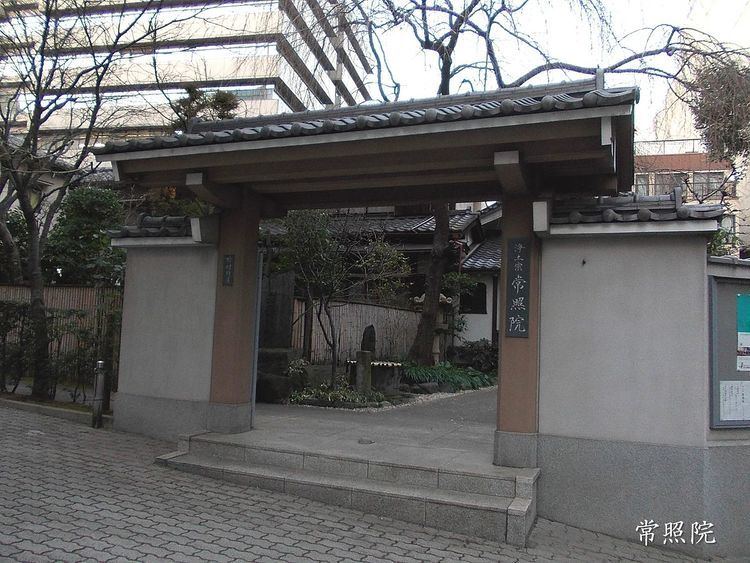Died 16 April 1727 | ||
 | ||
Shirakoya Okuma (白子屋 お熊, 1703–1727) was a Japanese woman whose crime made her the heroine of ningyō jōruri puppet plays.
Contents
Okuma was the eldest daughter of Shirakoya Shozaburo (白子屋 庄三郎), the head of a timber wholesaler in Shin-Zaimokucho, in the business district of Nihonbashi, in the city of Edo. Okuma later married Matashiro (又四郎).
She was the instigator of the Shirakoya Incident (白子屋事件, Shirokiya jiken), in which she conspired with her maid to try to kill her husband on 17 October 1726. She was caught and convicted, and on 7 December, the presiding judge Ōoka Tadasuke handed down a death sentence. On 25 February 1727, she was paraded through town and gibbeted. She was 23 years old. Her head was displayed in Asakusa, and then buried. Her grave is in Jyōshō-in (常照院, Josho Temple) in Minato, Tokyo.
Although the name Okuma means bear in Japanese, she was not ugly and her beauty contributed to her fame. Afterwards, Okuma and the Shirakoya Incident became the basis for multiple theatrical plays. She served as the model for Zaimokuya Okoma in the 1775 Japanese puppet play Girl in Love Old Eight Inch (恋娘昔八丈, Koi-musume Mukashi Hachijo), and for the heroine of Bai-u kosode mukashi hachi-jo, Kabuki drama written by Kawatake Mokuami.
Whole story
In the early morning of 17 October 1726, while sleeping, Matashiro, husband of Kuma, was cut at the neck with a shaver by Kiku (きく), maid of Shirakoya, when she was sixteen years old, then he fought back her in the result he was suffered a minor injury to his neck.
The Shirakoya family compromised with Matashiro's family. According to rumor, Matashiro and Kuma were unhappy married, and Kiku's motive for the crime was unexplained. Matashiro's family doubted Shirakoya's family, and reported the incident to the police on 20 November. Since the magistrate's office investigated Kiku, she made a confession solicitation of murder.
The investigator took Tsune and Kuma by the collar, who confessed to the plot. Originally ante nuptial contact with Kuma and Matashiro was mercenary marriage. In those days, the Shirakoya family had financial problems, and then Kuma married Matashiro for betrothal money. Kuma hated her husband, after marriage receiving menial Hisa (ひさ) guidance, Kuma had an intimate relationship with houseboy Chuhachi (忠八), being aware of one's daughter's adultery Tsune gave a favorable response to their love.
Kuma wanted divorce, but in that case she must pay back betrothal money, and thought if he died of disease she can divorce without refunded. At the outset, they had poison plan to kill, and came the roots over Yokoyama Ryugen (横山玄柳), a visually impaired massage practitioner, make him administer poison to Matashiro, but only upset his health but didn't result in death. When the plan failed, Tsune and Kuma were rushing into making decision that bounce Kiku into hack at Matashiro, but it bring their eggs to a bad market the plot came to light.
Resolution
Director of general Shozaburo, who failed oversight of one's family and employee and caused disturbance to the public, and Yokoyama Genshu, engaged in a plot in the dark were sentenced banishment from Edo. Kiku was sentenced to death, and Hisa was humiliated on parade and then went mount the scaffold for abetting Chuhachi adultery, Chuhachi was humiliate on parade and then went mount the scaffold, accessory Tsune was transportation. The main offender Kuma was sentenced humiliate on parade and then went mount the scaffold for intrigue and would-be murder. Before marriage, Kuma was known as acknowledged beautiful girl, during parade gather people in an effort to catch a glimpse of acknowledged wicked woman in the area along a road. It is said that Kuma forced to ride bareback wore dressed yellow eight length (黄八丈, kihachijo) short-sleeved kimono which was in Edo period it was hugely expensive in white Japanese underclothes and middleclothes and wore crystal bardroll around the neck was as though cope with the expectation of looker-on florid-looking and chanting a Buddhist sura aequo animo.
Aftermath
The beauty of Kuma and flashy performance during the parade caused repercussion in Edo., the incident has been made into numerous plays such as Kinsei eto chomon-shu (近世江都著聞集), Kyoho Tsu-gan (享保通鑑), Uen sho-setu yodan (兎園小説余録), Edo masago rokujyu-jyo kou-bon (江戸真砂六十帖広本), and Bue nenpho (武江年表).
